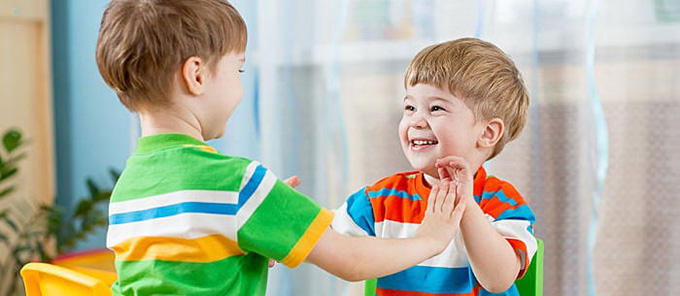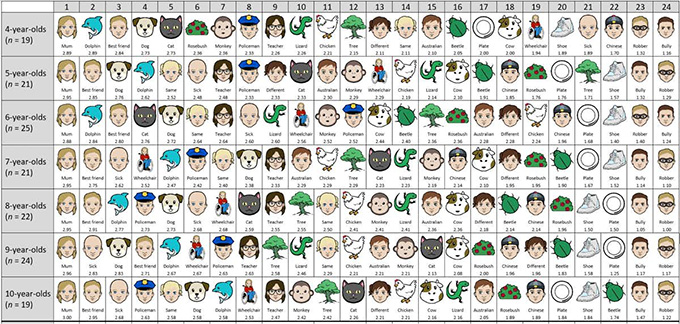
The school accompanies and cultivates children’s academic knowledge , measuring their progress in reading and numeracy. But what about their moral sense? A recent study shows that it also evolves over time and that parents can really contribute to its development.
While the moral concerns of adults have already been mapped , so far we have not known much about children and how that can change over time.
Our team of researchers at the University of Queensland looked at this moral development (about caring for the good of others, more specifically) and found that with age, children open up to more and more people and different subjects.
Social beings
We asked 151 four-year-olds at age 10 to tell us, from a range of 24 items, how much they cared about this or that. The palette included humans, animals and inanimate objects. The participants had to position each one of them in a “moral circle”, indicating whether they cared a lot, a little, or not at all.
We realized that children’s field of concern is becoming wider as they grow older. Their ability to pay attention to others improves as they develop, as do their math and reading skills. This means that there are several key moments in a child’s moral evolution as their understanding of others’ needs is refined.
We are fundamentally social beings: from an early age, children are encouraged to share, to help others and to be loved. The first helpful behaviors can be observed from the age of 18 months , then this attitude becomes common from 3 years. But this kind of behavior usually occurs only in situations where the help has no direct cost (for example, having to give something of value, like a toy that we like).
On the other hand, although a 4-year-old is aware that sharing is a positive gesture and punishing those who do not, it is very difficult for him to do it himself. During our study, we found that children of this age were the least likely to give the stickers they had just won to a classmate they did not know.
It is only later, at age 7 to age 8, that children begin to adopt more altruistic sharing postures. At this age, children are more receptive to social norms of fairness and justice. They will show dislike not only for situations in which they are given less than for another child, but also in cases where they themselves receive more than another.
This ability to integrate the experience of others into our own decision-making is the key to moral reasoning. It is this ability that can explain why children are much more concerned about vulnerable members of society – such as those who are sick or disabled.
While 4-year-olds were as little concerned about a person who was sick with a shoe, those aged seven and over said they cared a lot about it, integrating the person into the circle closest to their concerns. These older children also seem better able to mobilize for more abstract concepts, such as the environment.

If the elements at either end of the spectrum are stable, the order of the targets placed in the center changes a lot as the children grow up. Author provided
Becoming a moral being is a whole enterprise, which requires patience. So if your 4-year-olds seem more interested in their immediate environment than the people who need the most attention, give them time – they’ll do it.
Proximity criteria
Our study also shows that some moral preferences remain stable throughout life. Children of all ages give preference to family members and best friends, placing them in the first circle of their concerns.
In the same way, villains and malefactors are unanimously rejected: at all ages, children say they do not care about bullies or thieves. There is also a clear preference for members of a home group (those who are identified as classmates), compared to those of distant or unknown groups (children living abroad by example). These tendencies are also found among the adults being questioned, which would mean that they are inherent to the human condition.
But that does not mean that these preferences can not be influenced by experience. The mere fact of having more contact with a member of a distant group can promote identification, both in adults and children.
Likewise, reading stories that lead people with a disability can help reduce the prejudices of children five years of age and older. By enabling them to build relationships with people of diverse backgrounds, parents help develop the tolerance and empathy of their children.
Attitudes to encourage
This overview shows us that these choices refer to the origins of prejudice and tolerance. Understanding how these qualities emerge can help find solutions to overcome a priori and promote openness to others.
We all have a role to play, which can be expressed in different ways, such as:
- encourage your child to share with others
- highlight the similarities between the groups and not their differences
- read stories to children that incorporate a wide variety of characters
- explain why something is wrong rather than just condemning it
Thus, we can all help to awaken the moral concerns of future generations.
Author Bios: Karri Neldner is a PhD Candidate and Charlie Crimston is a Postdoctoral Research Fellow both at The University of Queensland
